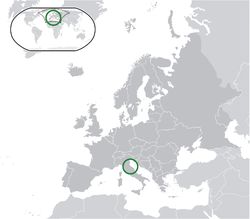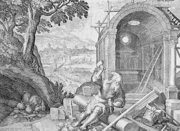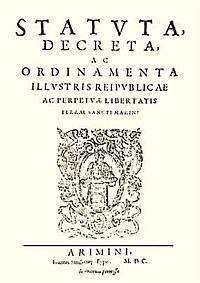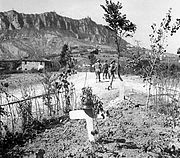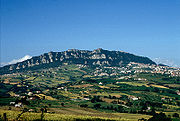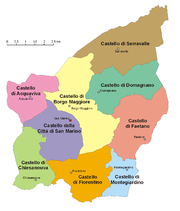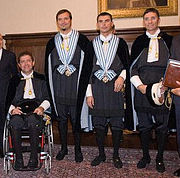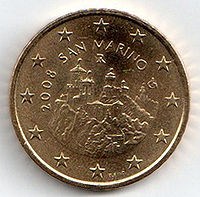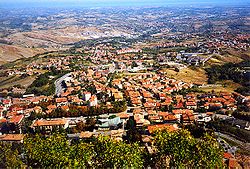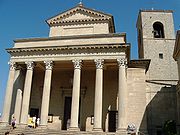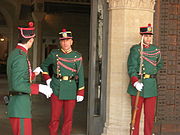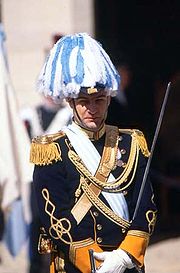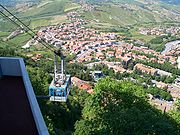
San Marino
Background to the schools Wikipedia
Arranging a Wikipedia selection for schools in the developing world without internet was an initiative by SOS Children. SOS Child sponsorship is cool!
| Most Serene Republic of San Marino Serenissima Repubblica di San Marino
|
||||||
|---|---|---|---|---|---|---|
|
||||||
| Motto: Libertas (Latin) "Freedom" |
||||||
| Anthem: " Inno Nazionale della Repubblica" | ||||||
| Capital | City of San Marino 43°56′N 12°26′E |
|||||
| Largest city | Dogana | |||||
| Official languages | Italian | |||||
| Ethnic groups | Sammarinese, Italian | |||||
| Demonym | Sammarinese | |||||
| Government | Parliamentary republic | |||||
| - | Captains Regent | Giovanni Francesco Ugolini Andrea Zafferani |
||||
| Independence from the Roman Empire | ||||||
| - | Date | 3 September 301 (traditional) | ||||
| - | Constitution | 8 October 1600 | ||||
| Area | ||||||
| - | Total | 61.2 km2 ( 219th) 24 sq mi |
||||
| - | Water (%) | 0 | ||||
| Population | ||||||
| - | March 31, 2010 estimate | 31,716 ( 209th) | ||||
| - | Density | 501/km2 1,297.6/sq mi |
||||
| GDP ( PPP) | 2008 estimate | |||||
| - | Total | $1.17 billion ( 177th) | ||||
| - | Per capita | $35,928 ( 24th) | ||||
| GDP (nominal) | 2008 estimate | |||||
| - | Total | US$1.44 billion ( 163rd) | ||||
| - | Per capita | US$44,208 ( 15th) | ||||
| Currency | Euro ( EUR) |
|||||
| Time zone | CET ( UTC+1) | |||||
| - | Summer ( DST) | CEST ( UTC+2) | ||||
| Drives on the | right | |||||
| Calling code | +378 | |||||
| Patron saint | St. Agatha | |||||
| ISO 3166 code | SM | |||||
| Internet TLD | .sm | |||||
San Marino, officially the Most Serene Republic of San Marino (pronounced /sæn məˈriːnoʊ/ san-mə-REE-noh; Italian: Serenissima Repubblica di San Marino), is a country situated on the eastern side of the Apennine Mountains. It is an enclave in Italy. Its size is just over 61 km2 (24 sq mi) with an estimated population of over 30,000. Its capital is the City of San Marino. One of the European microstates, along with Liechtenstein, the Vatican, Monaco, Andorra, and Malta, San Marino has the smallest population of all the members of the Council of Europe.
San Marino is the oldest surviving sovereign state and constitutional republic in the world, as the continuation of the monastic community founded on 3 September 301, by stonecutter Marinus of Arbe. Legend has it that Marinus left Rab, then the Roman colony of Arba, in 257 when the future emperor, Diocletian, issued a decree calling for the reconstruction of the city walls of Rimini, which had been destroyed by Liburnian pirates.
The constitution of San Marino, enacted in 1600, is the world's oldest constitution still in effect. The country's economy mainly relies on tourism, and San Marino's culture remains Italian, mainly Emilia-Romagnan in essence. It is one of the wealthiest countries in the world in terms of GDP (per capita), with a figure comparable to some of the more developed Italian regions, such as Lombardy and the Province of Bolzano-Bozen. San Marino is considered to have a highly stable economy, with the lowest unemployment rate in Europe, no national debt and a budget surplus.
History
According to tradition, Saint Marinus left the island of Rab in present-day Croatia with his lifelong friend Leo, and went to the city of Rimini as a mason. After the Diocletianic Persecution following his Christian sermons, he escaped to the nearby Monte Titano, where he built a small church and thus founded what is now the city and state of San Marino. The official date of foundation of the Republic is 3 September 301.
By the mid-5th century, a community was formed; because of its relatively inaccessible location and its poverty, it has succeeded, with a few brief interruptions, in maintaining its independence. In 1631, its independence was recognized by the Papacy.
The advance of Napoleon's army in 1797 presented a brief threat to the independence of San Marino, but the country was spared its liberty thanks to one of its Regents, Antonio Onofri, who managed to gain the respect and friendship of Napoleon. Thanks to his intervention, Napoleon, in a letter delivered to Gaspard Monge, scientist and commissary of the French Government for Science and Art, promised to guarantee and protect the independence of the Republic, offering to extend its territory according to its needs. The offer was declined by San Marino, fearing to provoke future revanchism that might threaten its freedom.
During the later phase of the Italian unification process in the 19th century, San Marino served as a refuge for many people persecuted because of their support for unification. In recognition of this support, Giuseppe Garibaldi accepted the wish of San Marino not to be incorporated into the new Italian state.
The government of San Marino made United States President Abraham Lincoln an honorary citizen. He wrote in reply, saying that the republic proved that "government founded on republican principles is capable of being so administered as to be secure and enduring."
20th century
During World War I, when Italy declared war on Austria-Hungary on 23 May 1915, San Marino remained neutral and Italy adopted a hostile view of Sammarinese neutrality, suspecting that San Marino could harbour Austrian spies who could be given access to its new radiotelegraph station. Italy tried to forcibly establish a detachment of Carabinieri in the Republic and then cut the Republic's telephone lines when it did not comply. Two groups of ten volunteers did, however, join Italian forces in the fighting on the Italian front, the first as combatants and the second as a Medical Corps operating a Red Cross field hospital. The existence of this hospital later caused Austria-Hungary to suspend diplomatic relations with San Marino.
From 1923 to 1943, San Marino was under the rule of the Sammarinese Fascist Party (PFS).
During World War II, San Marino remained neutral, although it had been wrongly reported on to have declared war on the United Kingdom on 17 September 1940.
Three days after the fall of Benito Mussolini in Italy, PFS rule collapsed and the new government declared neutrality in the conflict. The Fascists regained power on 1 April 1944 but kept neutrality intact. Despite that, on 26 June 1944 San Marino was bombed by the Royal Air Force, which mistakenly believed that the country had been overrun by German forces and was being used to amass stores and ammunition. At least 35 people were killed in the operation. San Marino accepted thousands of civilian refugees when Allied forces went over the Gothic Line. In September 1944, it was briefly occupied by German forces, who were attacked by Allied forces in the Battle of San Marino. Allied troops withdrew from the country shortly afterward.
The head of state is a committee (council) of two captains-regent. San Marino had the world's first democratically elected communist government, which held office between 1945 and 1957 and again between 2006 and 2008.
San Marino is the world's smallest republic, although when Nauru gained independence in 1968 it challenged that claim, Nauru's land mass being only 21 km2 (8.1 sq mi). However Nauru's jurisdiction over its surrounding waters (431,000 km2) is thousands of times greater than the territory of San Marino.
San Marino became a member of the Council of Europe in 1988 and of the United Nations in 1992. It is not a member of the European Union.
Geography
San Marino is an enclave in Italy, on the border between the regioni of Emilia Romagna and Marche and about 10 km (6.21 mi) from the Adriatic coast at Rimini. Its topography is dominated by the Apennine mountain range, and it has a rugged terrain. The highest point in the country, the summit of Monte Titano, is situated at 749 m (2,457 ft) above sea level. There are no bodies of water of any significant size. San Marino is the third smallest country in Europe, with only Vatican City and Monaco being smaller. San Marino has no natural level ground; it is entirely in the hills.
Climate
The climate is Mediterranean with continental influences, having warm summers and cool winters. The National Centre of Meteorology and Climatology of San Marino provides local forecasts.
Municipalities
San Marino is divided into the following nine municipalities, known locally as castelli (meaning "castles").
- San Marino (City of San Marino, officially Città di San Marino) is the capital.
There are also eight minor municipalities:
- Acquaviva
- Borgo Maggiore
- Chiesanuova
- Domagnano
- Faetano
- Fiorentino
- Montegiardino
- Serravalle
The largest town of the Republic is Dogana, which is not an autonomous castello, but rather belongs to the Castello of Serravalle.
In a similar way to an Italian comune, each castello includes a main settlement, called capoluogo, which is the seat of the castello, and some even smaller localities known as frazioni.
Hamlets
The republic is made up of 43 hamlets named curazie:
Cà Berlone, Cà Chiavello, Cà Giannino, Cà Melone, Cà Ragni, Cà Rigo, Cailungo, Caladino, Calligaria, Canepa, Capanne, Casole, Castellaro, Cerbaiola, Cinque Vie, Confine, Corianino, Crociale, Dogana, Falciano, Fiorina, Galavotto, Gualdicciolo, La Serra, Lesignano, Molarini, Montalbo, Monte Pulito, Murata, Pianacci, Piandivello, Poggio Casalino, Poggio Chiesanuova, Ponte Mellini, Rovereta, San Giovanni sotto le Penne, Santa Mustiola, Spaccio Giannoni, Teglio, Torraccia, Valdragone, Valgiurata and Ventoso.
Politics
San Marino has the political framework of a parliamentary representative democratic republic: the Captains Regent are the heads of state, and there is a pluriform multi-party system. Executive power is exercised by the government. Legislative power is vested in both the government and the Grand and General Council. The judiciary is independent of the executive and the legislature.
San Marino was originally led by the Arengo, initially formed from the heads of each family. In the 13th century, power was given to the Great and General Council. In 1243, the first two Captains Regent were nominated by the Council. As of 2010, this method of nomination is still in use.
The legislature of the republic is the Grand and General Council (Consiglio grande e generale). The Council is a unicameral legislature with 60 members. There are elections every five years by proportional representation in all nine administrative districts. These districts (townships) correspond to the old parishes of the republic.
Citizens 18 years or older are eligible to vote. Beside general legislation, the Grand and General Council approves the budget and elects the Captains Regent, the State Congress (composed of ten Secretaries with executive power), the Council of Twelve (which forms the judicial branch during the period of legislature of the Council), the Advising Commissions, and the Government Unions. The Council also has the power to ratify treaties with other countries. The Council is divided into five different Advising Commissions consisting of fifteen councillors who examine, propose, and discuss the implementation of new laws that are on their way to being presented on the floor of the Council.
Every six months, the Council elects two Captains Regent to be the heads of state. The Regents are chosen from opposing parties so that there is a balance of power. They serve a six-month term. The investiture of the Captains Regent takes place on 1 April and 1 October in every year. Once this term is over, citizens have three days in which to file complaints about the Captains' activities. If they warrant it, judicial proceedings against the ex-head(s) of state can be initiated.
The practice of multiple heads of state, as well as the frequent re-election of the heads of state, are derived directly from the customs of the Roman Republic. The Council is equivalent to the Roman Senate; the Captains Regent, to the consuls of ancient Rome.
San Marino is a multi-party democratic republic. The two main parties are the San Marinese Christian Democratic Party (PDCS) and the Party of Socialists and Democrats (PSD, a merger of the Socialist Party of San Marino and the former communist Party of Democrats) in addition to several other smaller parties, such as the San Marinese Communist Refoundation. It is difficult for any party to gain an overall majority, and most of the time the government is run by a coalition. In the June 2006 election the PSD won 20 seats on the Council and currently governs in coalition with the (liberal) Popular Alliance of Sammarinese Democrats for the Republic and United Left.
On 1 October 2007, Mirko Tomassoni was elected as one of the heads of state, making him the first disabled person ever to have been elected as captain regent.
San Marino is an associated state of Italy, which is responsible for its defense and which provides it an annual subsidy.
Economy
Although San Marino is not a European Union member, it is allowed to use the euro as its currency by arrangement with the Council of the European Union; it is also granted the right to use its own designs on the national side of the euro coins. Before the euro, the Sammarinese lira was pegged to, and exchangeable with, the Italian lira. The small number of Sammarinese euro coins, as was the case with the lira before it, are primarily of interest to coin collectors.
Other key industries are banking, electronics, and ceramics. The main agricultural products are wine and cheese.
San Marino's postage stamps, which are valid for mail only within the country, are mostly sold to philatelists and are a source of income. San Marino is a member of the Small European Postal Administration Cooperation.
The per capita level of US$55,449 and standard of living are comparable to those of Switzerland. San Marino imports goods such as food from Italy.
Taxation
The corporate profits tax rate in San Marino is 19 percent. Capital gains are subject to a five percent tax; interest is subject to a 13 percent withholding tax.
In 1972, a value added taxation (VAT) system was introduced in Italy, and was applied in San Marino, in accordance with the 1939 friendship treaty. In addition, a tax on imported goods, to be levied by San Marino, was established. Such taxes, however, were not, and are not, applied to national products. Until 1996, goods manufactured and sold in San Marino were not subject to indirect taxation.
Under the European Union customs agreement, San Marino continues to levy taxes, the equivalent of an import duty, on imported goods. Also, a general VAT was introduced, in replacement of the Italian VAT.
Tourism
The tourist sector contributes over 2.2% of San Marino's GDP, with approximately 2 million tourists visiting in 2009.
Demographics
The state has a population of approximately 30,000, including 1,000 foreigners, most of whom are Italians. About 5,000 Sammarinese live in foreign countries, predominantly in Italy.
The language spoken is Italian; Emiliano-Romagnolo is widely spoken, too. Citizens of San Marino enjoy one of the highest life expectancies in the world.
Religion
San Marino is a predominantly Catholic state — over 97% of the population profess the Catholic faith, but it is not the established religion. Approximately half of those who profess to be Catholic practice the faith. There is no episcopal see in San Marino. Historically, the various parishes in San Marino were divided between two Italian dioceses, mostly in the Diocese of Montefeltro, and partly in the Diocese of Rimini. In 1977, the border between Montefeltro and Rimini was readjusted so that all of San Marino fell within the diocese of Montefeltro. The bishop of Montefeltro-San Marino resides in Pennabilli, in Italy.
However, there is a provision under the Income tax rules that the tax payers have the right to request for allocation of 0.3 % of their income tax to the Catholic Church or to "other" charities. The Churches include the two religious groups of the Waldesian Church and Jehovah's Witnesses.
The Roman Catholic Diocese of San Marino-Montefeltro was until 1977 the historic diocese of Montefeltro. It is a suffragan of the archdiocese of Ravenna-Cervia. The current diocese includes all the parishes of San Marino. The earliest mention of Montefeltro, as Mona Feretri, is in the diplomas by which Charlemagne confirmed the donation of Pepin. The first known bishop of Montefeltro was Agatho (826), whose residence was at San Leo. Under Bishop Flaminios Dondi (1724) the see was again transferred to San Leo, but later it returned to Pennabilli. The historic diocese was a suffragan of the archdiocese of Urbino.
There has been a Jewish presence in San Marino for at least 600 years. The first mention of Jews in San Marino dates to the late 14th century, in official documents recording the business transactions of Jews. There are many documents throughout the 15th to 17th centuries describing Jewish dealings and verifying the presence of a Jewish community in San Marino. Jews were required to wear special badges and live by specific restrictions, but were also permitted official protection from the government.
During World War II, San Marino provided a harbour for more than 100,000 Italians ( which was 1000 percent of the then population of the country) and Jews from Nazi persecution. This action was considered a proud act by the citizens and government officials of the country. Today, there are only small numbers of Jews in San Marino.
Military
San Marino has one of the smallest military forces in the world. National defence is, by arrangement, the responsibility of Italy's armed forces. Different branches have varied functions including: performing ceremonial duties; patrolling borders; mounting guard at government buildings; and assisting police in major criminal cases.
Crossbow Corps
Although once at the heart of San Marino's army, the Crossbow Corps is now a ceremonial force of approximately eighty volunteers. Since 1295, the Crossbow Corps has provided demonstrations of crossbow shooting at festivals. Its uniform is medieval in design, and although a statutory military unit, it has no military function today.
Guard of the Rock
The Guard of the Rock is a front-line military unit in the San Marino armed forces, a state border patrol, with responsibility for patrolling borders and defending them. In their role as Fortress Guards they are responsible for guarding the Palazzo Pubblico in San Marino City, the seat of national Government. In this role they are the forces most visible to tourists, and are known for their colourful ceremony of Changing the Guard. Under the 1987 statute the Guard of the Rock are all enrolled as 'Criminal Police Officers' (in addition to their military role) and assist the police in investigating major crime. The uniform of the Guard of the Rock is a distinctive red and green.
Guard of the Council Great and General
The Guard of the Council Great and General commonly known as The Guard of the Council or locally as the 'Guard of Nobles', formed in 1740, is a volunteer unit with ceremonial duties. Due to its striking blue, white, and gold uniform, it is perhaps the best-known part of the Sammarinese military, and appears on countless postcard views of the republic. The functions of the Guard of the Council are to protect the Captains Regent, and to defend the Great and General Council during its formal sessions. They also provide a ceremonial bodyguard to government officials on festivals of both state and church.
The Army Militia
In former times, all families with two or more adult male members were required to enroll half of them in the Army Militia. This unit remains the basic fighting force of the armed forces of San Marino, but is largely ceremonial. It is a matter of civic pride for many San-Marinese to belong to the force, and all citizens with at least six years residence in the republic are entitled to enroll.
The uniform is dark blue, with a kepi bearing a blue and white plume. The ceremonial form of the uniform includes a white cross-strap, and white and blue sash, white epaulets, and white decorated cuffs.
The Military Ensemble
Formally this is part of the Army Militia, and is the ceremonial military band of San Marino. It consists of approximately fifty musicians. The uniform is similar to that of the Army Militia. Military Ensemble music accompanies most state occasions in the republic.
The Gendarmerie
Established in 1842, the Gendarmerie of San Marino is a militarised law enforcement agency. Its members are full-time and have responsibility for the protection of citizens and property, and the preservation of law and order.
The entire military corps of San Marino depends upon the co-operation of full-time forces and their retained (volunteer) colleagues, known as the Corpi Militari Volontari, or Voluntary Military Force.
Transport
There are 220 km of roads in the country, the main road being the San Marino Superhighway. Sammarinese authorities license private vehicles with distinctive licence plates which are white with blue figures and the coat of arms, usually a letter followed by up to four numbers. Many vehicles also carry the international vehicle identification code (in black on a white oval sticker), which is "RSM".
There are no airports in San Marino, but there is an international heliport located in Borgo Maggiore. Most tourists who arrive by air land at Federico Fellini International Airport close to the city of Rimini, then make the transfer by bus.
Two rivers flow through San Marino, but there is no major water transport, and no major port or harbour.
Public transport
San Marino has limited public transport facilities. There is a regular bus service between Rimini and the city of San Marino, popular with both tourists and tourist industry workers commuting to San Marino from Italy. This service stops at approximately twenty locations in Rimini and within San Marino, with its two terminus stops at Rimini railway station and San Marino coach station, respectively.
A limited licensed taxi service operates nationwide. There are seven licensed taxi operating companies in the republic, and Italian taxis regularly operate within San Marino when carrying passengers picked up in Italian territory.
There is a 1.5 km (0.93 mi) aerial tramway connecting the city of San Marino on top of Monte Titano with Borgo Maggiore, a major town in the republic, with the second largest population of any San Marinese settlement. For the visitor the aerial tramway gives the best views of Borgo Maggiore, as the cars sweep low over the rooftops of the main town square. From here a further connection is available to the nation's largest settlement, Dogana, via the local bus service.
Two aerial tramway cars (gondolas) operate in opposition on a cable, and service is provided at roughly fifteen minute intervals throughout the day. A third vehicle is available on the system, a service car for the use of engineers maintaining the tramway.
Railway
Today, there is no railway in San Marino, but for a short period prior to World War II, it had a single narrow-gauge line, connecting the country with the Italian rail network at Rimini. Due to the difficulties in accessing the capital, San Marino City, with its mountain-top location, the terminus station was planned to be located in the village of Valdragone, but was extended to reach the capital through a steep and winding track comprising many tunnels. The railway was opened on 12 June 1932. An advanced system for its time, it was an electric railway, powered from overhead cables. It was well built and had a high frequency of passengers, but was almost completely destroyed during World War II. Many facilities such as bridges, tunnels, and stations remain visible today, and some have been converted to parks, public footpaths, or traffic routes.


